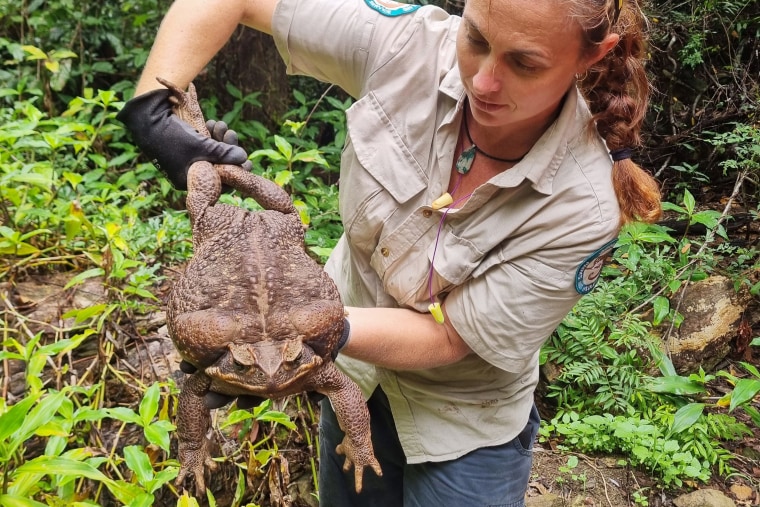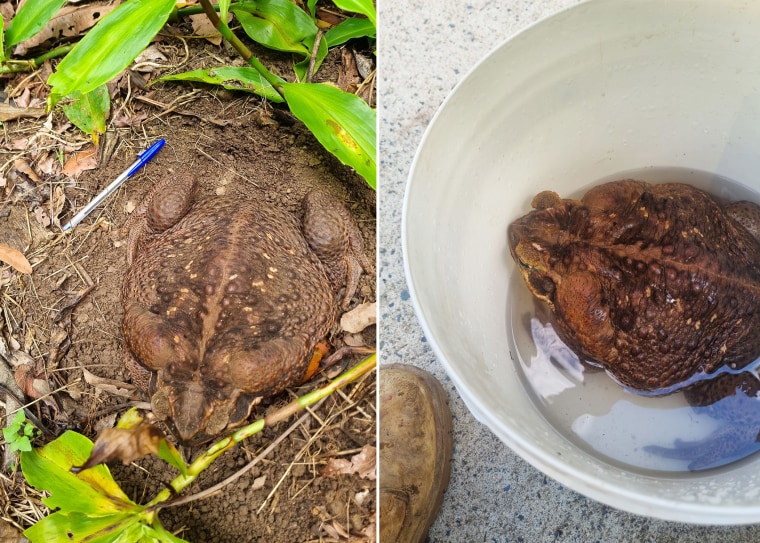In the wild rainforest of Australia’s north, park rangers have stumbled upon a predator so large they felt they had no choice but to dub it Toadzilla.
The giant cane toad was discovered Jan. 12 by rangers who were conducting track work in Conway National Park in the state of Queensland.
A snake slithering across the track beside the Conway Circuit serendipitously forced the team to stop their vehicle, Ranger Kylee Gray recounted, leading her to step out, look down and gasp when she spotted the toad.
“I reached down and grabbed the cane toad and couldn’t believe how big and heavy it was,” she said in a statement from the Queensland Department of Environment and Science.
“We believe it’s a female due to the size, and female cane toads do grow bigger than males,” Gray added.
Though not this big, usually.

According to the Guinness World Records, the current record held for the world’s largest toad is at 2.65 kilograms (5.8 pounds), measuring at 38 centimeters (1.3 feet) from snout to vent. The record was set in March 1991 by a cane toad owned by a Swedish man.
“When we returned to base, she weighed in at 2.7 kilograms, which could be a new record,” Gray said of the newly discovered Toadzilla.
The team had initially considered calling the large amphibian Connie after Conway National Park, she said in an interview with the state broadcaster ABC on Friday, but ultimately settled on naming it after the fictional monster.
“We dubbed it Toadzilla, and quickly put it into a container so we could remove it from the wild,” Gray said in the statement.
Not unlike its namesake, Toadzilla was viewed as a grave threat to its surroundings.
“A cane toad that size will eat anything it can fit into its mouth, and that includes insects, reptiles and small mammals,” Gray said.
While pigeons and rats are considered stubborn pests in many countries, cane toads carry the crown as one of Australia's most invasive pests.
With this in mind, the giant toad was “humanely euthanized,” according to a statement from the Department of Environment and Science, due to the risk of environmental damage.

The species was introduced to Queensland state in 1935 to control the cane beetle, a pest for sugar cane plantations.
The amphibian — often brown and encrusted with large warts — can grow up to 26 centimeters (10.2 inches) and weigh up to 2.5 kilograms (5.5 pounds), although the department said cane toads of this size are rare.
Cane toads like this are considered a threat to biodiversity. They can quickly colonize habitats, due to the fact female cane toads can produce up to 30,000 eggs in a season, it said.
They can also be “fatally poisonous to wildlife,” according to the statement.
With no control method or biological control agent to target cane toads without harming native species, they must laboriously be collected and removed by hand, according to the New South Wales Environment and Heritage Group, which oversees the Australian state of New South Wales, where cane toads are also spreading.
The cane toad has been linked to the decline and extinction of several of its predators, including the northern quoll — also known as the northern Australian native cat — which is now endangered in northern Australia, according to the group.
But Toadzilla’s legacy will live on — authorities said its body was donated to the Queensland Museum for research.
CORRECTION (Jan. 20, 2023, 8:15 a.m. ET): A previous version of this article and a headline misstated when Toadzilla was discovered. It was Jan. 12, not Jan. 19. The article also misspelled part of the name of a native species. It is the northern quoll, not quall.